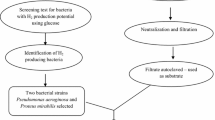Abstract
Diversified group of bacteria were screened for carbonic anhydrase (CA) activity. Significant CA activity was found in crude enzyme extracts of Enterobacter and Aeromonas isolates while minimal or negligible CA activity was observed in case of Shigella and Klebsiella spp. Optimization and characterization study of potent CA producing isolates revealed that the maximum enzyme activity of 3.86 EU/ml was observed in E. taylorae and the optimum pH range for enzyme stability was found to be 7.5–9.0 along with an optimum temperature range of 35–50 °C. The molecular mass of CA was 29-kDa indicating α-type with periplasmic and cytosolic location. Present investigation for the first time reports CA in diversified genus and optimized parameters for enhanced production of CA in Enterobacter sp. & Aeromonas sp. from fresh water bodies that inturn lay down grounds for exploitation of CA from E. taylorae as an efficient catalyst for CO2 sequestration within a bioreactor.
Similar content being viewed by others
References
Kupriyanova E, Villarejo A, Markelova A, Gerasimenko L, Zavarzin G, Samuelsson G, Los DA & Pronina N (2007) Extracellular Carbonic anhydrases of stromatolite forming cyanobacterium Microcoleus cathonoplastes. Microbiology 153:1149–156
Bond GM, Stranger J, Branchvold DK, Sinsek FA, Medina NG & Egeland G (1999) Development of integrated system for biomimetic CO2 Sequestration using the enzyme carbonic anhydrase. Energy & Fuels 15:309–31
Smith KS & Ferry JG (2000) Prokaryotic Carbonic anhydrases. FEMS Microbiol Rev 24:335–366
Adler L, Brundell J, Falkbring SO & Nyman PO (1972) Carbonic anhydrase from Nisseria sicca strain 6021. Bacterial Growth and Purification of enzyme. Biochemica et Biophysica Acta 284:313–323
Alber BE & Ferry JG (1994) A carbonic anhydrase from the archaeon Methanosarcina thermophila. Proc Natl Acad Sci USA 91:6909–6913
Braus-Stromeyer S, Schnappauf G, Braus GH, Gobner A & Drake HL (1997) Carbonic anhydrase in Acetobacterium woodii. J Bacteriol 179:7197–7200
Gill SR, Fedorka PJ, Tweten RK & Sleeper BP (1984) Purification and Properties of Carbonic anhydrase of Rhodospirullum rubrum. Arch Microbiol 138:113–118
Yagawa Y, Shiraiwa Y & Miyachi S (1984) Carbonic anhydrase from the blue green algae (cyanobacterium) Anabaena variabilis. Plant Cell Physiol 25:775–783
Buzolyova LS & Somov G (1999) Autotrophic assimilation of CO2 and C1 compounds by pathogenic bacteria. Biochem (Moscow) 64 (10):1357–1361
Smith KS, Zakubzick C, Whittam TS & Ferry JG (1999) Carbonic anhydrase is an ancient enzyme wide spread in prokaryotes. Proc Natl Acad Sci USA 96:15184–15189
Dean CR & Ward OP (1992) The use of EDTA or polymixin with lysozyme for the recovery of intracellular products from Eschericia coli. Biotechnology Techniques 6 (2):133–138
Wilbur KM & Anderson NG (1948) Electrometric and Colorimetric determination of Carbonic anhydrase. J Biolchem 176:147–154
Lowry OH, Rosenbrough NJ, Forr AL & Randall RJ (1951) Protein measurement with Folin Phenol Reagent. J Biolchem 193:265–275
Smith KS & Ferry JG (1999) A plant type (β-Class) carbonic anhydrase in the thermophilic methanoarchaeon Methanobacterium thermoautotrophicum. J Bacteriol 181:6247–6253
Ames G, Prody FL & Kustu S (1984) Simple, rapid and quantitative release of periplasmic proteins by choloroform. J Bacteriol 160:1181–1183
Russel M & Model P (1982) Filamentous phage precoat is an integral membrane protein: analysis by a new method of membrane preparation. Cell 28:177–184
Laemmli UK (1970) Cleavage of structural proteins during the assembly of head of bacteriophage T4. Nature (London) 227:680–685
Merlin C, Masters M, Mcteer S & Corlson A (2003) Why is carbonic anhydrase essential to E. coli. J Bacteriol 185(21): 6415–6424
Charles HP & Roberts (1968) Carbon dioxide as a growth factor for mutants of E. coli. J Gen Microbiol 51:211–224
Demir N, Demir Y & Coskum P (2001) Purification and characterization of carbonic anhydrase from human erythrocyte plasma membrane. Turk J Med Sci 31:477–482
Demir Y, Demir N, Nadarglu H & Bakan E (2000) Purification and characterization of carbonic anhydrase from bovine erythrocyte plasma membrane. Biochem & Biotechnol 30 (1):49–59
Stahler MF, Ganter L, Katherin L, Manfred K & Stephen B (2005) Mutational analysis of Helicobacter pylori carbonic anhydrases. FEMS Immunol Medical Microbiol 44:183–189
Park IS & Hausinger RP (1995) Requirement of carbon dioxide for in vitro assembly of urease nickel metallocenter. Sci 267:1156–1158
Earnhardt JN, Qian MC, Lakkis MM, Bergenhem NC, Laipis PY, Tashian RE & Silverman DM (1998) The catalytic properties of marine carbonic anhydrase VII. Biochem 37:10837–10845
Chirica LC, Elleby B, Jonsson BH & Lindskog S (1997) The complete sequence, expression in E. coli, purification and some properties of carbonic anhydrase from Nisseria gonorrhoeae. Eur J Biochem 244:755–760
Chirica L, Peteresson C, Hurtig M, Jonsson BH, Boren T & Lindskog S (2002) Expression and localization of α and β Carbonic anhydrase in Helicobacter pylori. Biochemica and Biophysica Acta 160:192–199
Li W, Yu LJ, Wu Y, Jia LP & Yuan DX (2007) Enhancement of calcium release from limestone by microbial extracellular carbonic anhydrase. Bioresource Tech 98:950–953
Pushkas LG, Inui M, Zahan K & Yukawa H (2000) A periplasmic α-type carbonic anhydrase from Rhodopseudomonas palustris is essential for bicarbonate uptake. Microbiology 146:2957–2966
Rawat M & Moroney JV (1995) The regulation of carbonic anhydrase and ribulose 1,5 biphosphate carboxylase / Oxygenase activase by light and CO2 in Chlamydomonas reinhardtii. Plant Physiol 109:937–944
Author information
Authors and Affiliations
Corresponding author
Rights and permissions
About this article
Cite this article
Sharma, A., Bhattacharya, A., Pujari, R. et al. Characterization of carbonic anhydrase from diversified genus for biomimetic carbon-dioxide sequestration. Indian J Microbiol 48, 365–371 (2008). https://doi.org/10.1007/s12088-008-0045-y
Received:
Accepted:
Published:
Issue Date:
DOI: https://doi.org/10.1007/s12088-008-0045-y




